
Flowers & Other Plants
A Riddle: What's Real and False?
And the answer is..."Climbing False Buckwheat." It is a real plant, but its name says it is false. The honors of identifying the plant and flowers that I post photos of below again go to Dr. Ed Lickey. Thanks, Ed!
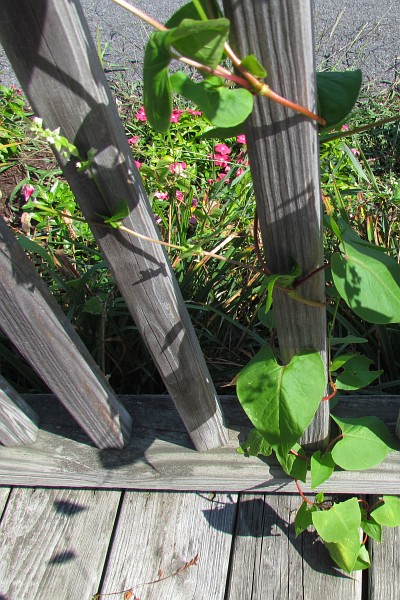
Climbing False Buckwheat (26-Aug-13; © Richard L. Bowman)
At close range, the white flowers are really green and white and rather complex.
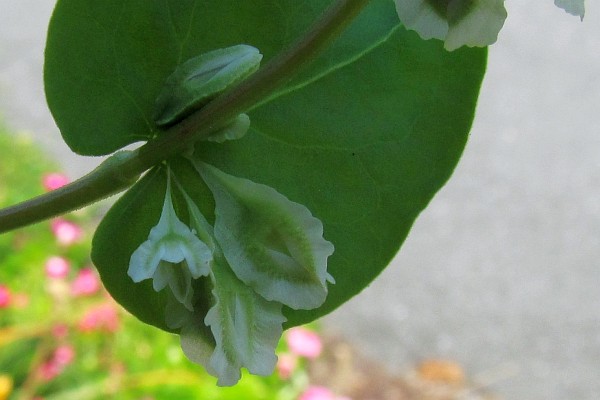
Close-up of Climbing False Buckwheat Flowers (26-Aug-13; © Richard L. Bowman)
According to the site, "Wildflowers of Illinois in Savannas & Thickets," this plant is a native plant as opposed to many of the so-called weeds I have featured. However, we did not want it in our flower bed, so I have since removed it.
August 29, 2013
Neglect Is Sometimes Good
I find it very difficult to let a living plant go to the trash or even the compost pile. So some plants get shoved to a window in our basement to either survive in spite of our neglect or because of it. This has been the case for a Moth Orchid (Phalaenopsis) we have. These plants produce medium-sized blooms, about 3 inches (7.5 cm) across at the widest part, and are fairly inexpensive at larger chain stores. The Cymbidium orchids that are used in corsages are usually bigger than this, and the native orchid we found in the wild and grew on a post of our porch in Belize was much smaller than this.
Back to my theme of neglect, we rescued one of these Moth Orchids from the room where my mother-in-law had lived when she died on May 6, 2012. So it went down to our basement window. Every couple of weeks, or even longer, I would remember to water it. About a week ago, I noticed that it was blooming, so maybe my neglect kept it from being overwatered!
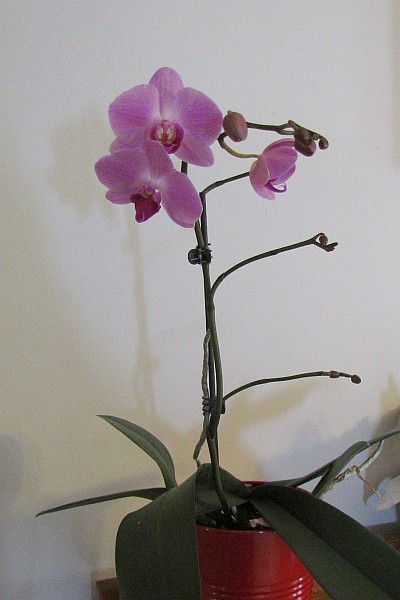
Moth Orchid Plant in Bloom (26-Aug-13; © Richard L. Bowman)
As usual, I like a close-up view, too!
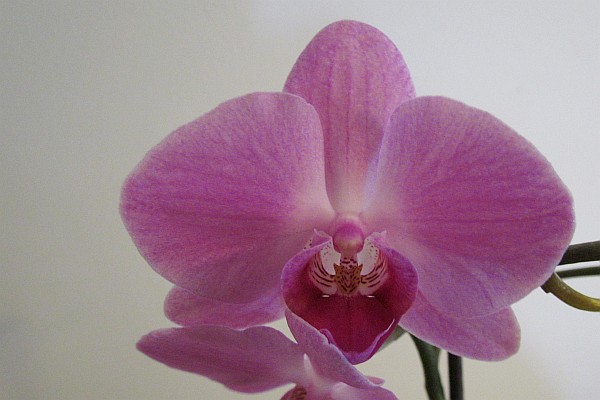
Moth Orchid Bloom (26-Aug-13; © Richard L. Bowman)
For more reliable hints on taking care of these and other orchids, check out the Canadian Orchid Congress.
Mushrooms grow best by neglect. Or at least they grow best on damp untended lawns, such as ours! Here is a lovely example I found earlier this week as I began to mow our lawn of grass, white clover and lots of other wild weeds.
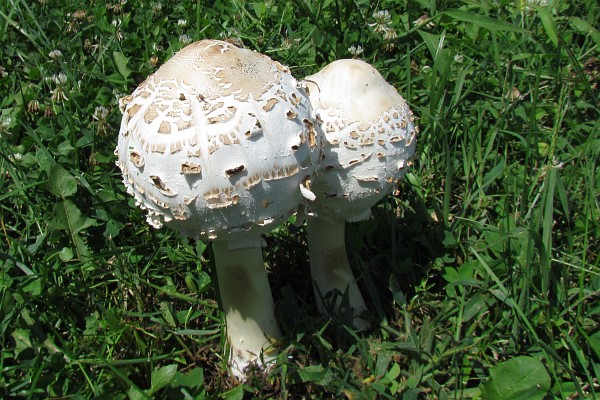
Mushrooms on Our Lawn (I) (26-Aug-13; © Richard L. Bowman)
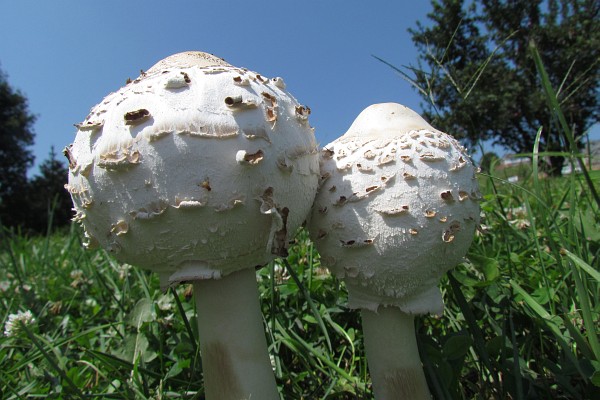
Mushrooms on Our Lawn (II(26-Aug-13; © Richard L. Bowman)
I would caution all of us to not eat wild mushrooms unless we are ABSOLUTELY sure of the kind we have. As one example of the difficulty of identifying mushrooms, MushroomExpert.com says, "...young specimens [of Green-spored Parasol] in the 'button' stage are nearly inseparable from the very similar Chlorophyllum rhacodes [Shaggy Parasol]."
"Poisonous Plants of North Carolina" designates the Green-Spored Parasol as being "HIGHLY TOXIC, MAY BE FATAL IF EATEN!" While not noted as quiet that toxic, the readers of First-Nature.com are urged to consider that Shaggy Parasol "has been known to cause serious illness in some people and so picking it to eat, intentionally or otherwise, should be avoided."
So I am not sure which mushroom I have captured in these photos, but I can enjoy their visual beauty without consuming them!
August 26, 2013
What's In a Name?
This morning I was proud that I had identified a new weed, so I told Elsie about it at breakfast. She thought that either common name sounded terrible. So where do our common names come from? Hmmm....
The weed (and I did admit to Elsie that I was wrong initially to think it was flowers from last year that had reseeded themselves), is called Horseweed or Marestail. First is the photo of a flower pot on our deck with the weed growing very nicely in it1!
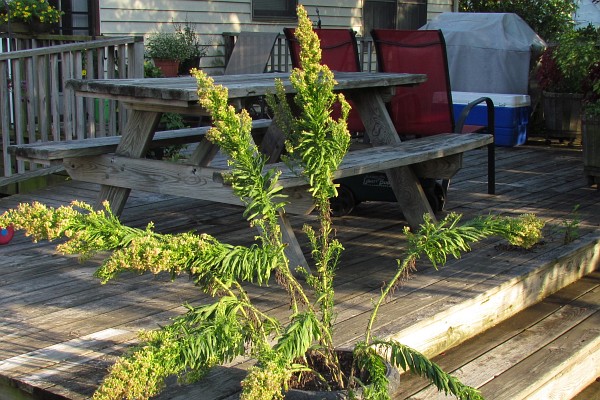
Horseweed Plant (25-Aug-13; © Richard L. Bowman)
The flowers are very tiny and on close-up look like miniature Dandelions.
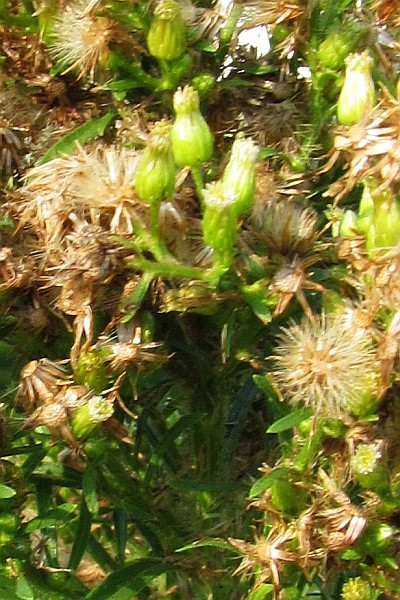
Close-up of the Horseweed Flowers (I) (26-Aug-13; © Richard L. Bowman)
And I also got my thumb in my work--on purpose of course. :)

Close-up of the Horseweed Flowers (II) (26-Aug-13; © Richard L. Bowman)
Next we move to a domesticated flower--the Black-eyed Susan. Who would ever have named a flower as if it were a person? Compare this first photo with one I took on July 31. There are even more blooms than there were then!
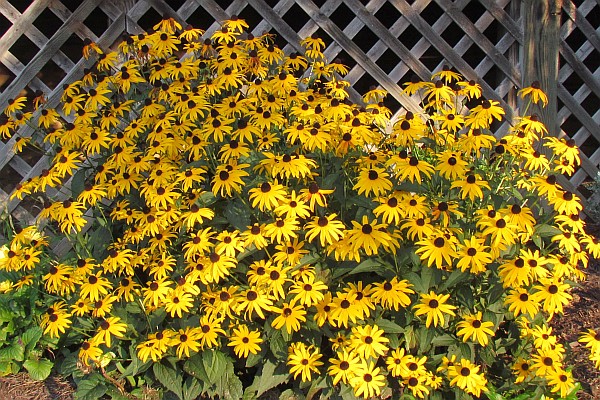
Black-eyed Susan Flowers (26-Aug-13; © Richard L. Bowman)
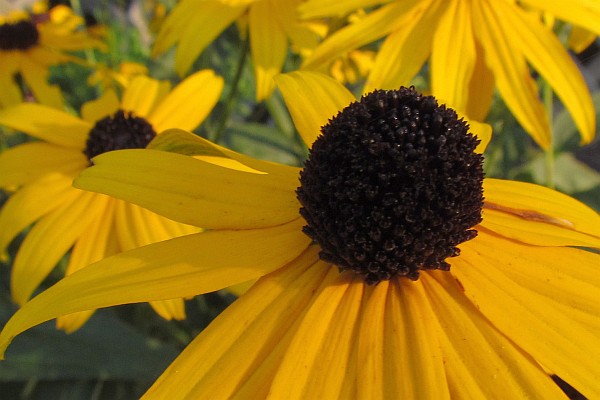
A Close-up of a Black-eyed Susan Flower (26-Aug-13; © Richard L. Bowman)
And finally here is another photo of one of our Sunflowers. It is now mature enough that it is bending over, as they usually do.
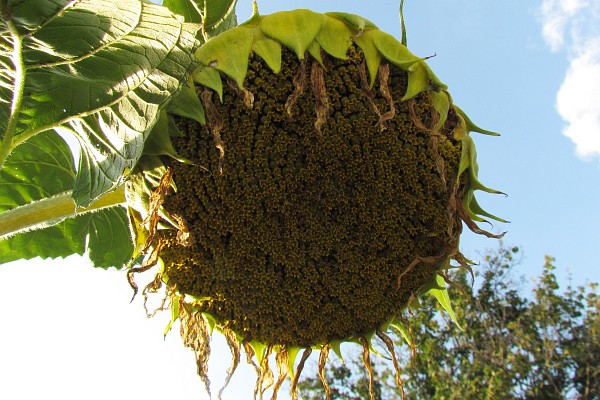
Black-eyed Susan Flowers (25-Aug-13; © Richard L. Bowman)
There is always something new to check out!
August 9, 2013
Hibiscus in Many Forms
Several years ago, soon after my wife and I planted our small Hibiscus seedling from her sister, we shared a discussion about whether it was an Hibiscus or a Rose of Sharon. As it turns out, the Rose of Sharon is a type of Hibiscus. The Hibiscus genus is large and contains flowers of different sizes and colors. On February 3 and 6, I showed pictures of a large Red Hibiscus, sometimes called "flor de Jamaica," that my sister has growing at her house near Washington, DC. Below I show the "Rose of Sharon" variety that we have growing at our house.
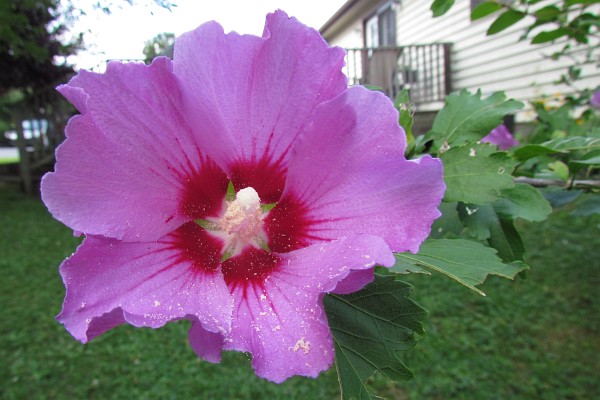
"Rose of Sharon" Hibiscus Flower (7-Aug-13; © Richard L. Bowman)
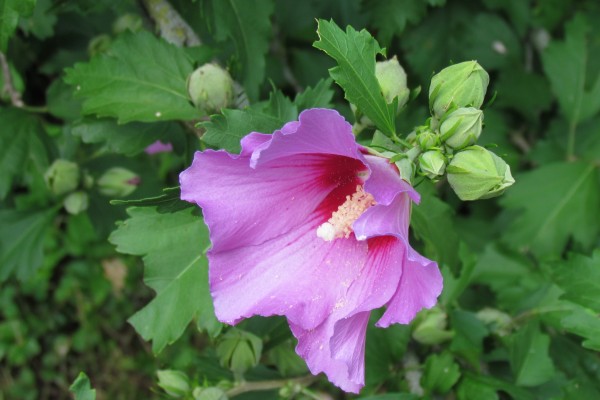
"Rose of Sharon" Hibiscus Flower with Buds (7-Aug-13; © Richard L. Bowman)
Strangely, this year a number of white Hibiscus flowers came from the center of our "Rose of Sharon." Anyone know what they are, or why they have shown up after 25 years?
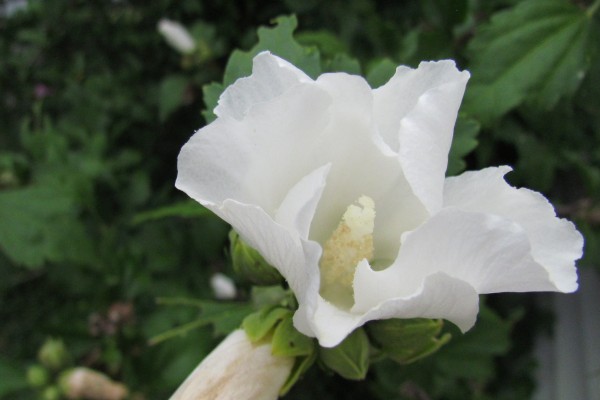
This Unknown Hibiscus Flower Came from the Center of Our "Rose of Sharon" (7-Aug-13; © Richard L. Bowman)
And just to show some variety, here is an apple on one of our dwarf trees. We have not sprayed them this year, as usual :(, so there is some insect damage.
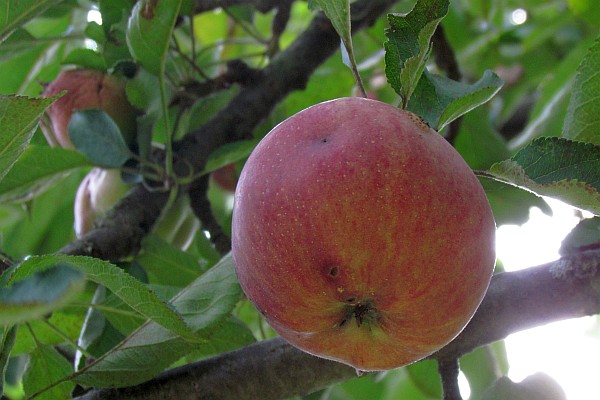
Apple (with insect damage) (8-Aug-13; © Richard L. Bowman)
Next year I am determined to take better care of our apple trees. Maybe saying it in public will help me stay on task.
August 1, 2013
What's Yellow, White and Brown?
It has to be summer flowers time. Here are some from the past few days.
But first here is something green--a lot of it! Our one hill of Zucchini has been very prolific even with just a couple of plants. Or as it was sid when we lived in Oregon, USA, the Zucchini is the closest thing to being a weed without actually being one.
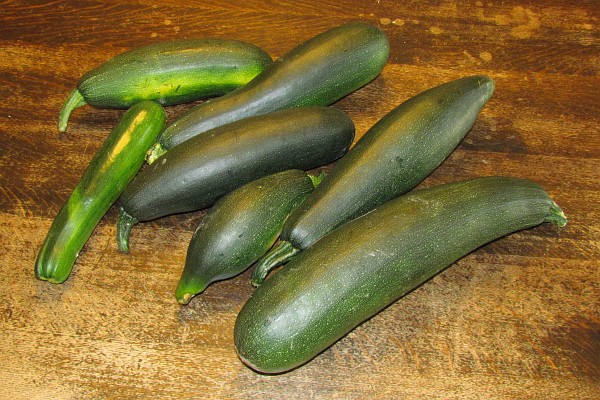
One Day's Zucchini, Harvest, Harrisonburg, VA, USA (30-Jul-13; © Richard L. Bowman)
In our front flower bed by the mailbox, white Gladioli (pl. for Gladiolus) are adding there unique growth pattern to the venue.
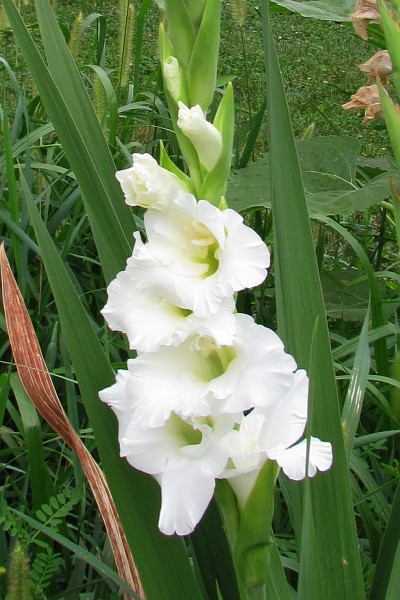
Gladiolus Blooms, Harrisonburg, VA, USA (31-Jul-13; © Richard L. Bowman)
And I had to look closer to see the immature and mature innards to the blooms.
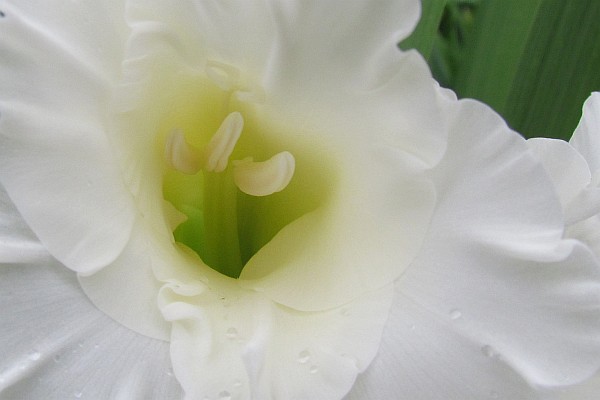
Close-up of a Young Gladiolus Bloom, Harrisonburg, VA, USA (31-Jul-13; © Richard L. Bowman)
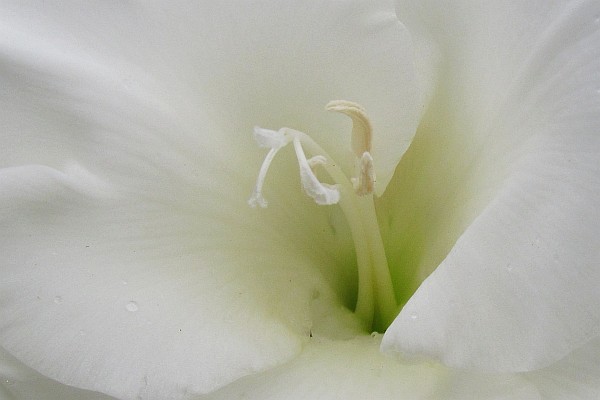
Close-up of a Mature Gladiolus Bloom, Harrisonburg, VA, USA (31-Jul-13; © Richard L. Bowman)
BTW, if you are interested in identifying the inner parts of the Gladiolus flower, visit the Ohio State University course page on it.
While we had not planted any Sunflowers, several have come up anyway (from seeds that birds dropped from our feeder). And I do like their large head of yellow flowers with large, intricate centers. With a head of about 9 inches (23 cm) across, these are one of the smaller verities.
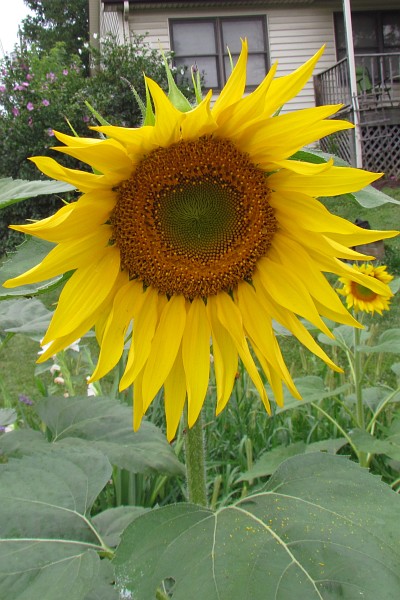
One of Many Sunflowers Misplaced in our Flower Beds, Harrisonburg, VA, USA (31-Jul-13; © Richard L. Bowman)
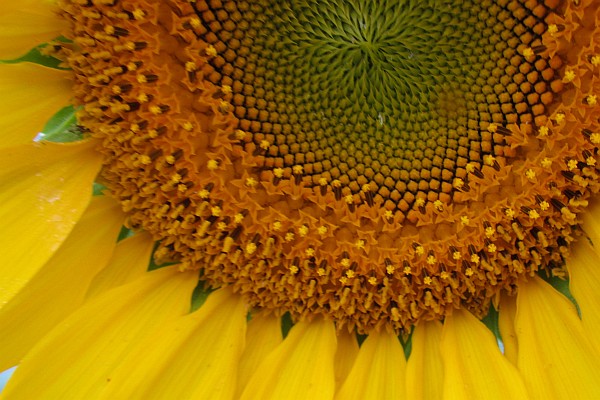
Close-up of Sunflower Head, Harrisonburg, VA, USA (31-Jul-13; © Richard L. Bowman)
And how about an even closer look?
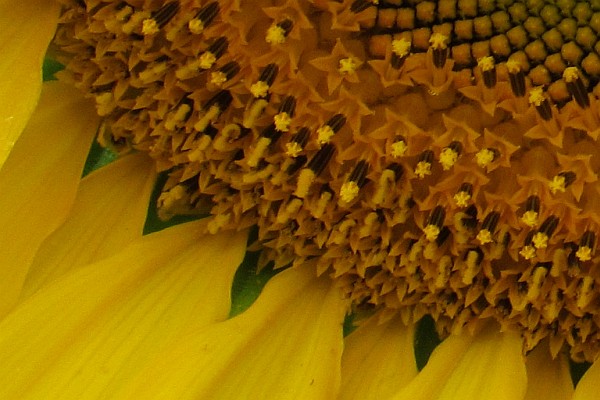
Sunflower Close-up Showing Details, Harrisonburg, VA, USA (31-Jul-13; © Richard L. Bowman)
To identify the parts of the composite head of the Sunflower, visit another Ohio State University course page.
This summer our Black-eyed Susan Flower cluster is huge--about 3 1/2 feet (1 m) across.
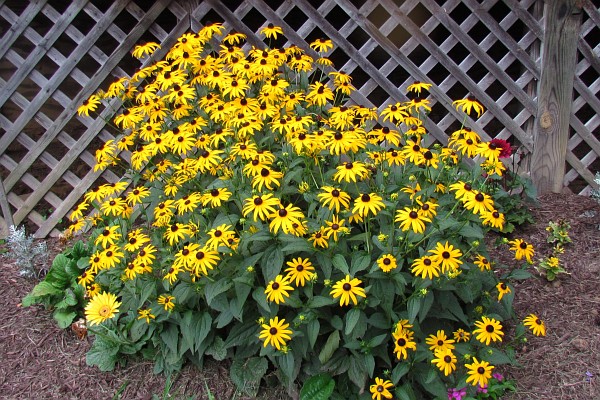
Cluster of Black-eyed Susan Flowering Plants, Harrisonburg, VA, USA (31-Jul-13; © Richard L. Bowman)
Although much smaller, in close-up a Black-eyed Susan Flower resembles the Sunflower. And, sure enough, checking out their Wikipedia pages shows that they are members of the same family.
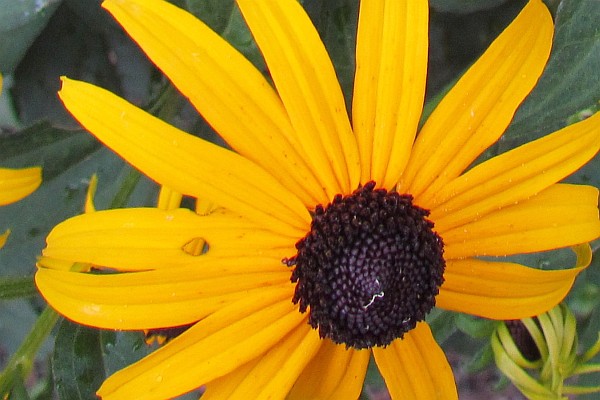
A Close-up of Chicory, in our front yard, Harrisonburg, VA, USA (8-Jul-13; © Richard L. Bowman)
Last evening Elsie helped me realize that the Black-eyed Susan vine has the same name as the Black-eyed Susan plant. However, checking out Wikipedia again, I discovered that the two Black-eyed Susans are actually in two different families! Hmmm...can we try renaming one or the other. I now have to go back and edit the captions on my vine photos.
--©2013, Richard L. Bowman